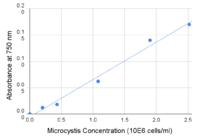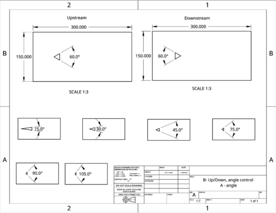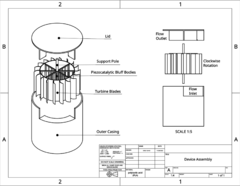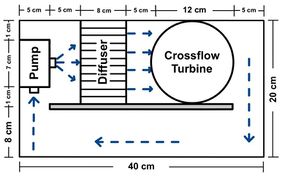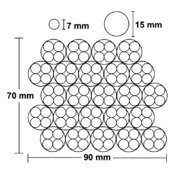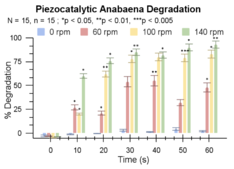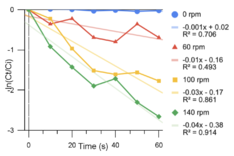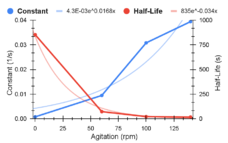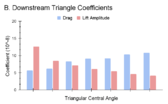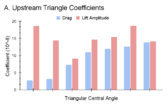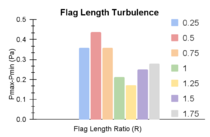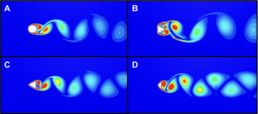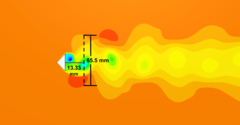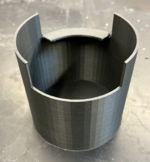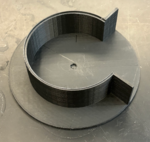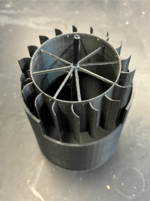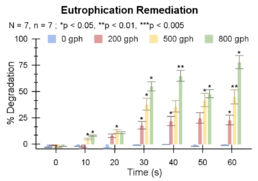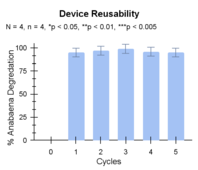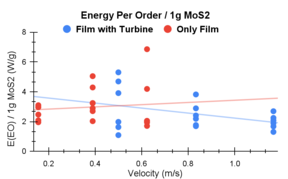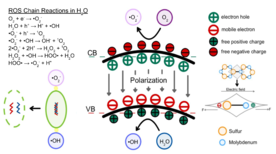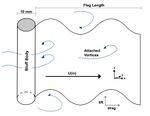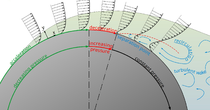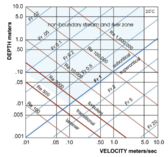Abstract
Eutrophication affects 65% of coastal and 53% of freshwater regions in the US but no scalable cyanobacterial degradation methods exist. Piezocatalysis harnesses mechanical energy to produce reactive oxygen species (ROS) in water, which degrade organic pollutants by oxidation without generating toxic residues. This study designed a novel hydro-turbine using bluff bodies that maximize kinetic flow energy available for aquatic remediation via piezocatalysis. MoS2-doped films exhibited first-order ROS chain reaction production when agitated in Anabaena (20 μg/L), and has potential to inhibit cyanobacterial positive feedback growth by converting nitric products into reactive nitrogen species. The inverted piezo-active flag model was computationally optimized to enhance polarization with turbulent energy and ensure rapid charge dispersion with flow-induced vibrations. The 90° upstream triangle yielded maximum coefficients by effective flow separation (12.6 drag, 18.6 lift) and a flag length ratio of 0.75 was optimal while avoiding canceling zones. The optimized piezocatalytic hydro-turbine design yielded 78% remediation under 800gph for 60s (p=0.032). A minimum flow speed was identified by energy/order to be 0.5m/s, with 0.7W/(1g MoS2). Application depth of 0.3m-2m was identified with cyanobacterial concentration, turbulence needed for crossflow effectiveness, and speed; conditions are within industrial scalability standards. Chain reactions allow the remediation of still-water and high-volume downstream regions through tributaries. In the future, the device can be studied in environments with varying meander speeds and upstream ROS exposure times. The device presents a potential industrial eutrophication treatment applicable in ~93% of fluvial environments.
1. Introduction
According to the National Ocean Service, 65% of coastal regions and 53% of surface freshwater in the contiguous United States are affected by eutrophication: nutrient over-enrichment that results in the overgrowth of algae, increase in aerobic bacterial decomposition of organic matter, and reduction in dissolved oxygen in the aquatic ecosystem [17]. Eutrophication hypoxia results in immense biodiversity loss, and cytotoxins produced by cyanobacteria pose dire human and environmental health risks [5]. Economically, losses in water access and costs of ecosystem restoration in the United States total an estimated annual $2.2 billion in surface freshwater [8].
Current methods of eutrophication restoration include mechanical removal of biomass, biomanipulation, and chemical purification. However, these methods are often ineffective and unsustainable in treating and preventing recurring eutrophic events over time, as the presence of nutrients persists well after their introduction to the ecosystem [7]. Furthermore, methods of nutrient/biomass removal create secondary wastes [6].
Microbial communities in natural environments are especially difficult to remediate, as the use of antibiotics poses risks of developing antibiotic-resistant species. Therefore, reactive oxidative species (ROS) such as hydrogen peroxide have been of interest in use for environmental remediation by chemically eliminating pollutants without producing byproducts [12]. Specifically, advanced oxidation processes (AOP) that generate ROS are a rising approach towards wastewater pollution and algal bloom management, as they are efficient and effective, environmentally compatible with minimal chemical and energy waste [9].
Piezocatalysis is an AOP method that requires no electrical/solar energy input, harnessing mechanical energy such as deformation stresses into activation energy required in chemical reactions [2]. When mechanical energy deforms piezo-active material, stresses applied on a macroscopic and microscopic scale to the materials’ particular molecular orientations produce spontaneous polarization parallel to dipoles. The bending of conduction/valence bands to reach internal electrochemical equilibrium creates piezoelectric potential. This internal electric field propagates to the material surface and produces ROS upon electron-hole pair contact with H2O. Chain reactions produce ROS free radicals such as O2-•, HO•, and 1O2 that readily attach to organic pollutants.
In 2016, Wu et al studied the use of molybdenum disulfide (MoS2) as a piezocatalytic material and the metabolomic pathways taken for the inactivation of Escherichia coli with ROS produced. MoS2 is of great interest for its ferroelectric and non centrosymmetric structure, which induces spatial polarization on active surface sites and specific crystallographic directions upon distortion. Properties of easy deformation and ability to withstand strain make MoS2 especially piezoelectric and piezocatalytic applications in water flow [10]. Despite the production of ROS, MoS2 was found to have mild cytotoxicity due to low solubility, indicating biocompatibility in natural environments. Wu et al identified the release of lactate dehydrogenase as evidence of inactivation due to bacterial membrane damage. Furthermore, Escherichia coli produced ROS itself, when induced by ROS exposure. Eventual inactivation was due to intracellular oxidative damage, shrunken cells, and inhibition of pyruvate metabolism [22]. Moreno-Andres et al specifically implemented ROS H2O2 and S2O72- for inactivating cyanobacteria in freshwater ecosystem blooms, finding high, long-lasting efficiency and sensitivity to low populations [15].
Piezocatalysis is especially applicable in aquatic lotic ecosystems, as water flow energy is consistently available and ROS poses insignificant toxicity threats. However, a significant limitation preventing the implementation of piezocatalysis in the water remediation industry is the lack of a practical design that maximizes effectiveness and minimizes environmental disruption [21]. Further investigation is also necessary to understand the efficiency of electrochemical remediation within complex hydrological dynamics that govern the environment [16].
The incorporation of bluff bodies into piezoelectrics has potential to maximize kinetic energy of fluid flow available to be harvested by piezo-active materials. Specifically, triangular shapes maximize the conversion of flow energy while minimizing body area [20].Vortex shedding behind bluff bodies creates highly variable flow velocities resulting in asymmetric and turbulent flow. The inverted bluff body piezo-flag model is especially effective for its ability to convert low speed flow into higher forms of energy such as vortex-induced vibrations (VIV) and turbulence [6].
Mehdipour et al analyzed the variation in bluff body shape and piezoelectric “flag” configurations to maximize VIVs for low-speed wind energy harvesting. Using computational fluid dynamics and voltage testing, a relationship between lift/drag coefficients (CL/CD) and piezoelectric activity is confirmed. Longer flags were found to be ideal for lower velocity flows, and an inverted bluff body created higher pressure differences and “flapping amplitudes” [13]. Bernoulli’s principle establishes an inverse relationship between fluid velocity and pressure. Through this, flapping results as incompressible fluids traveling at higher velocities create low-pressure regions. A flag present in fluids of high-pressure variation induced by vortices experiences more deformation.
Despite successes in incorporating bluff bodies into piezoelectrics, using this solution to address eutrophication requires a method of application that is industrially/economically practical, and can treat large volumes of flowing water both efficiently and effectively. Engineering designs in the hydropower industry have been tailored to process flowing water in the environment. Specifically in the lotic regions that are impacted by eutrophication, the crossflow turbine processes flow from an inlet to an outlet, and shows potential to scale the inverted bluff body piezo-flag model [19].
This study aims to implement environmental remediation methods into industrially applicable methods using engineering design. By analyzing advanced redox processes of piezocatalytic MoS2, optimizing bluff body shapes and piezocatalytic flag length using computational fluid dynamics, and assessing their compatibility by designing a novel crossflow turbine, an energy-neutral, cost effective, and biologically applicable solution can be created. It is hypothesized that MoS2-doped polyvinylidene fluoride (PVDF) will effectively remediate Anabaena cyanobacteria upon exposure to agitation, triangular bluff bodies will be more effective than cylindrical bodies for maximizing energy in laminar flow, and the crossflow turbine will be able to effectively remediate a large volume of flowing water.
2. Materials and Methods
Standard Methods
1. Piezocatalytic Film Synthesis [4]
Flexible piezocatalytic film was synthesized with solution casting to form PVDF films doped with MoS2. 250 mg of PVDF (Sigma Aldrich) was dissolved in 60 mL of dimethyl sulfoxide (DMSO) (Sigma Aldrich) under magnetic stirring at 60°C until a homogeneous solution formed. 7.361 g of MoS2 powder (Sigma Aldrich) was added to obtain a 10 wt% of PVDF and magnetically stirred at room temperature until a uniform dispersion was achieved. The total suspension weighed roughly 73.61g and was transferred to a sterile petri dish. The suspension was dried in an oven (Bouwald, Amazon) at 80° until a film formed. A control was produced with the same procedures but without MoS2.
2. Cyanobacterial Pollutant
Algal solutions in experimentation had a concentration of 20 μg/L, as this level of Anabaena indicates severe algal blooms with health risks [5] (CDC). A pipette was used to collect cuvettes of samples at 10-second intervals without stopping mixing until a minute was reached. Samples were let sit for 24 hours, and the change in concentration of Anabaena was measured using Equation 1, where X = Anabaena degradation (ratio), Ci = initial concentration (μg/L), Ct = concentration after time (μg/L).
2.1. Cultivation [23]
Anabaena sp. (Carolina Biological) was cultured in room lighting and room temperatures. Erlenmeyer flasks wrapped in aluminum foil were autoclaved for 15 minutes for sterilization. The flasks were filled with Alga-Gro® Freshwater Medium. Algae cultures were distributed equally among the flasks and pipetted into the liquid medium. A rubber stopper with 2 holes was inserted, with 1 hole including tubing for pumping air for media circulation, and the second hole for gas exchange and maintaining pressure equilibrium. The culture was kept at room temperature and room lighting. The culture was monitored frequently, and growth curves were plotted over time for exhibition of the lag, exponential, and stationary phases. Cultivation continued until the mid-log phase.
2.2. Concentration Spectroscopy
Anabaena concentration was determined with a Vernier UV-visible spectrophotometer at an optical density wavelength of 750 nm. Vernier Spectro-Analysis software was used to measure absorbance. A Beer-Lambert Law calibration plot (Figure 1) was constructed with standard solutions at concentrations of 10 μg/L, 500 μg/L, 1 mg/L, and 5 mg/L. Absorbance was plotted against concentration, and the direct relationship observed was analyzed with Beer’s Law. (Equation 2). Slope was calculated with a line of best fit, where A = absorbance, ε is the molar absorptivity coefficient (M/cm), l = length of light path through cuvette (cm), and c = concentration (M). If not analyzed within 3 hours of collection, samples were frozen and stored in the dark until analysis to prevent growth.
Figure 1. Linear regression Beer Lambert’s Concentration Plot for Anabaena cyanobacteria;
y = 0.071x + -5.43x10-3, R2 = 0.988.
Phase I - Piezocatalytic Reaction Kinetics
Piezocatalytic conversion of mechanical energy to chemical reaction energy was investigated.
1. Experimental Degradation
Piezocatalytic film was cut into identical squares 20 mm x 20 mm. Films with a uniform thickness of 0.5mm were used. Each trial consisted of 150 mL of Anabaena solution mixed with a magnetic mixer. Samples were collected and analyzed using standard methods noted previously. Conditions were kept constant in all trials conducted.
2. Agitation
The effect of agitation on piezocatalysis was measured by changing the amount of energy applied through mixing. Experimental groups were mixed at 0 rotations per minute (rpm) (control), 60 rpm, 100 rpm, and 140 rpm. Differences in Anabaena degradation over time of these groups were used to determine the chemical kinetics of piezocatalysis, and data was analyzed with SPSS version 25 through a one-Way ANOVA with a Post-Hoc Scheffe (p<0.05).
Phase II - Computational Fluid Dynamics Optimization
Parameters of the inverted bluff body piezo-active flag model were optimized using computational fluid dynamics simulations by their ability to convert laminar flow to VIV energy and turbulent energy.
1. Simulation Domain
The cloud computer-aided software program SimScale was used for large eddy simulations. Top views of 2D vortex-shedding formations were visualized by rendering vorticity and pressure fields. Simulations analyzed incompressible fluid with a laminar flow model and transient time dependency. A PISO (pressure-implicit with splitting of operators) algorithm was used with 0 passive species for calculations. The fluid domain was kept constant in every simulation, and variables were calculated using the same methods and reference length of 10 mm.
1.1. Geometry
Volumes were imported from CAD OnShape for computational domains. They were rectangular regions of 300 x 150 mm streamwise to transverse dimensions, with a depth of 5mm. The bluff body was vertically centered and located 75 mm from the upstream boundary, with a diameter of 20 mm.
1.2. Grid Boundary Conditions
A no-slip condition was assigned to the 5 mm width wall corresponding with the bluff body exterior. This created a range of flow velocities and subsequent vortex shedding. Slip conditions were assigned to all remaining 4 walls for no inference in vorticity.
The entire volume was characterized as water in a Newtonian viscosity model. Kinematic viscosity (v) was defined as 0.9338mm2/s and density (ρ) was defined as 997.3 kg/m3. Standard initial conditions were used with no initial gauge static pressure, no initial velocity, and no subdomains. A fixed value velocity inlet of 0.02 m/s was assigned to the 5 mm width face upstream. This velocity was calculated to maintain a Reynolds number of 300 for a transitional laminar to turbulent state optimal to create organized Karmán vortex shedding. A corresponding 0 Pa fixed value pressure outlet was assigned to the 5 mm width face downstream to allow for free flow.
1.3. Simulation Solver Algorithm
The PISO algorithm contained 4 correctors, 1 non-orthogonal corrector, and no pressure references. A smooth solver was used for velocity and GAMP was used to solve pressure. 100 seconds was simulated with a Δt of 0.1 seconds. The write interval was 10 seconds and 10 time frames were captured with a Scotch decompose algorithm.
1.3.1. Computational Mesh Grid
A hex-dominant internal meshing mode was used to create a fine mesh grid with automatic refinement at boundary layers, characterized by the number of cells and nodes. An additional refinement of 0.0005 m was made at 160 mm x 100 mm.
Figure 2. Simulation domain computational mesh for the cylindrical control. Each domain contains a refinement of 0.0005 mm at 160 mm x 100 mm and along the boundary layer edges.
2. Bluff Body Shapes
Bluff bodies were optimized with a focus on triangles. The reference length of 10mm was kept constant as the cylindrical diameter and triangular length perpendicular to flow. Experimental groups simulated a cylinder (control), triangles pointing upstream, and triangles pointing downstream. For triangular groups, experimental groups simulated triangles with central angles of 15°, 30°, 45°, 60°, 75°, 90°, and 105°. Calculated CL and CD correspond with the ability of the shape to convert laminar flow to VIV energy.
Figure 3. Dimensionally identical computational domain geometries with reference length 20mm triangles are imported from CAD Onshape. The optimal upstream shape is further analyzed by varying central angles from 15° to 105°.
3. Piezo-Active Flag Length
After identifying the optimal bluff body shape, piezo-active flag lengths were simulated as distance ratios relative to the 10 mm reference length. Experimental groups measured pressure experienced over time at ratios of 0.25, 0.5, 0.75, 1, 1.25, 1.5, and 1.75. Calculated pressure variations correspond with turbulent energy harnessed behind the bluff body. The mixing amplitude of the system was found by using ImageJ to annotate the pressure field of the optimal flag length with the optimal bluff body shape.
Phase III - Eutrophication Remediation Turbine
A novel device was designed to incorporate piezocatalytic inverted bluff body flag systems into a crossflow turbine structure. The device was assessed for applicability in varying conditions.
1. Engineering Design
Bernoulli’s principle was applied to the exterior dimensions of the turbine to create a low pressure inner chamber, maximizing fluid velocity within the turbine. The volume of the inner chamber was equal to the volume of the outer chamber. Adhikari and Wood’s study of maximizing the efficiency of crossflow hydro turbines was used for turbine rotor dimensions. The outer edge is at a 39° inlet flow angle and the inner edge is at 22° [1].
1.1. Function
Under use, the fluid inlet pointing upstream directed water into the upper outer chamber, where it pushed the turbine blades and bluff bodies as it moved down. On the bottom of the device, the fluid enters the inner chamber and experiences remediation from optimized rotating piezocatalytically active bodies before exiting the device via the downstream fluid outlet.
1.2. Assembly
The device was designed in CAD Onshape using optimized parameters. The 4-part assembly was sliced at 0.3 mm with UltiMaker Cura before 3D printed by the Monoprice Maker Select 3D printer with polylactic acid filament (PLA). Parts were assembled using Original Gorilla Glue and piezocatalytic film was attached to bluff bodies with epoxy.
Figure 4. Completed schematic of turbine assembly.
2. Simulated Flow Environment
A simulated flow environment was created in a 20 liter tank. An aquarium pump was calibrated to flow rates prior to use. A plastic sheet divider split the tank to create up and downstream sides of flow, and a diffuser (Figure 6) was created with silicone tubing and placed after the pump to maintain laminar, controlled flow. Parts were fixed to the tank using Gorilla silicone sealant.
Figure 5. Top view of 28 cm tall tank; flow simulation environment.
Anabaena was added to 8L of water in the tank after stable flow was established. The turbine device was submerged when the tank’s solution was mixed to be homogeneous. Samples were collected and analyzed using standard methods noted previously. Conditions were kept constant in all trials conducted.
Figure 6. Side-view of diffuser constructed for laminar flow.
3. Flow Rate
The effect of varying flow rate conditions was tested using the aquarium pump. Experimental groups were exposed to 0 gallons per hour (gph) (control), 200 gph, 500 gph, and 800 gph. Differences in Anabaena degradation of these groups were used to determine the functionality of the device in varying environments, and data was analyzed with SPSS version 25 through a one-Way ANOVA with a Post-Hoc Scheffe (p<0.05).
4. Reusability
The effect of long periods of use on device functionality was tested by repeating cycles of use, with each cycle lasting 24 hours at 800 gph flow. The tank was emptied and refilled in between cycles to ensure controlled remediation and ROS production. Experimental groups exposed the device to 0 (control), 1 cycle, 2 cycles, 3 cycles, 4 cycles, and 5 cycles. Anabaena degradation was measured in between cycles, and differences in remediation of these groups was used to determine the reusability and durability of the device. Data was analyzed with SPSS version 25 through a one-Way ANOVA with a Post-Hoc Scheffe (p<0.05).
5. Kinetic Energy per Order
To analyze if the bluff bodies and turbine design are effectively maximizing the piezo-activity of piezocatalytic film, the energy per order for every gram of MoS2 of all Anabaena degradation trials in phases I and III were calculated using Equation 3 [10], where EEO = energy used to degrade a 1 order of contaminant in 1 m3 of solution (W), P = flow power (W), t = treatment time (h), V = volume treated (m3), ci/cj = initial/final concentration (mol/L).
3. Results
Figure 7 presents the remediation of Anabaena facilitated by piezocatalysis over time. A maximum degradation of 93% was achieved after 1 minute of piezocatalytic exposure at 140 rpm. Negative controls without MoS2 yielded an average 3.9% cyanobacterial growth.
Figure 7. Anabaena degradation increased both under increased time of piezocatalytic exposure and under increased agitation.
Because a positive, logarithmic relationship was observed over time, it can be concluded that piezocatalysis occurred as a first order reaction. Chemical kinetics were analyzed using the integrated rate law (Equation 4), where A = concentration (μg/L), t = time (s), and k = rate constant.
(Equation 4)
Figure 8 presents the linearized degradation of Anabaena as a first-order reaction, and the linear relationship equations between time and logarithmic degradation associated with each level of agitation tested.
Figure 8. First Order Reaction Kinetic Plot of Anabaena degradation by time of piezocatalytic exposure and agitational level.
The slope of each line represents the rate constant associated with the reaction, and was used to find the half life of Anabaena in each condition (t1/2) (Equation 5). The change in rate constant and half life was found to be exponential to the level of agitation applied (Figure 9).
Figure 9. Change in k-value rate constant and half life with agitation applied.
Computational fluid dynamic simulations identified the 90° upstream triangle as optimal for maximizing vibrational energy due to its high CL and CD (Figure 10). The cylindric control had a CD and CL of 8.88, respectively. The upstream triangles were generally more efficient than the cylindric control, whereas the downstream triangles were generally less efficient.
Figure 10. Coefficients of upstream (A), and downstream (B) triangular bluff bodies simulated.
Pressure variations behind the optimal 90° upstream triangle bluff body were greatest at the 0.5 ratio (Figure 11). This identified the 0.75 length ratio as optimal for a piezo-active flag for its ability to avoid canceling zones [13].
Figure 11. Pressure variation calculated at reference length ratios behind the optimized bluff body.
Figure 12. Vorticity fields for the cylindric control (A), 60° upstream (B), 60° downstream (C) triangles, and optimized 90° upstream triangle (D) rendered at 80s from 0 Hz (blue) to 5 Hz (red).)
Using the optimal bluff body shape and flag length, the mixing amplitude of the system was found to be at a ratio of 6.55 with the flag length (Figure 13).
Figure 13. Pressure field of optimal bluff body rendered at 80s from -1 Pa (blue) to 5 Pa (red) annotated with ImageJ.
Figures 14-16 present a deconstructed view of the final 3D printed turbine (not to scale). CFD optimized parameters of bluff body shape, bluff body dimensions, flag length, and flag mixing amplitude were used to design the inner turbine. 90° upstream flowing triangles with reference lengths of 6 mm were set on supports 19.65 mm away from each other, separated by 2 flag mixing amplitudes. The inner layer of bluff bodies was separated by 1 flag mixing amplitude from the support pole. Each bluff body has a 1 mm wide, 2 mm deep split downstream for the attachment of a 4.5 mm piezocatalytic film at a 0.75 ratio from the 6 mm reference length. By keeping bluff bodies on this circle at least 1 flag length from the next, a total of 8 radial layers of piezo-active bodies were created. Figure 4 displays the completed inner turbine model.
Figure 14. Turbine cap.
Figure 15. Turbine exterior.
Figure 16. Deconstructed 4-part turbine assembly.
A maximum remediation of 78% was achieved by the turbine after 1 minute of piezocatalytic exposure under 800 gph flow (Figure 17). The final device exhibited no significant change in degradation in between cycles for a week when MoS2 film was reused (Figure 18).
Figure 17. The turbine effectively degraded Anabaena with piezocatalysis. Efficiency increased with flow rate and time of agitational exposure. Negative controls without MoS2 yielded an average growth of 6.1%.
Figure 18. Anabaena degradation measured in between cycles.
Calculating EEO of all experimental trials ran presented the effectiveness of bluff bodies and the turbine design (Figure 19). Since less energy used is more efficient, lower EEO values represent greater piezo-efficiency.
Figure 19. Energy per order by velocity of flow for piezocatalytic film mixed independently (red) and applied within the turbine structure (blue).
4. Discussion
Piezocatalytic Reaction Kinetics
Anabaena served as an effective model species of cyanobacteria to improve reliability and applicability of data collected for its ability to survive in a larger spectrum of conditions. Anabaena produces microcystin toxins that contribute to an accelerated growth pattern [14], and is characterized as having lower oxidative sensitivity due to heterocyst defense cells [12].
MoS2-doped PVDF served as a cheap but effective piezocatalytic film. The polarizability of the PVDF film base enhanced MoS2 dielectric properties [11], and its flexibility facilitated material deformation critical for piezo-active properties. Interestingly, the piezocatalytic film synthesized exhibited slight absorbent properties [10], due to the lack of Anabaena growth in positive controls where the film contained MoS2 but was not agitated. For comparison, the negative controls that lacked MoS2 exhibited an average 3.9% increase in Anabaena concentration (Figure 7).
MoS2 can be confirmed to be a piezocatalytic material since Anabaena degradation increased as agitation increased (Figure 7). This trend reflects piezo-active properties of the film; as agitation deforms the piezocatalytic material, internal polarization creates electric fields that propagate to the material surface, reacting with surrounding water to produce ROS (Figure 20). Specifically, MoS2 has a high piezo potential for containing asymmetrical trigonal prismatic layers that easily slip under deformation [11]. This, combined with a high ferroelectric potential [4], increases the frequency of polarization and decreases the gap between conduction and valence bands.
Figure 20. Deformation of piezocatalytic MoS2 film produces ROS that degrades Anabaena by intracellular oxidation.
Piezocatalysis degradation of organic pollutants with ROS was identified to have kinetics of a first-order chemical reaction. Therefore, the rate of ROS production is dependent on the concentration of ROS currently in the water (Equation 6). The unusual exponential change in k-value and half-life occurring with agitation further supports the effect of an external factor (Figure 9). These characteristics are likely due to the ROS chain reactions that occur in water (Figure 20), which create a negative feedback loop decreasing the rate of ROS production over time [15]. This would also explain why degradation occurred primarily during the period of rest after the initial agitation and piezocatalytic exposure. Because of these chain reactions, piezocatalysis has potential to induce a continued remediatory effect over time.
Environmentally, ROS production in piezocatalysis is applicable for the potential to regulate the positive feedback proliferation of cyanobacteria in eutrophication. ROS reacts with nitric products associated with algal growth [9] to form reactive nitrogen species such as peroxynitrite and nitrite (Equation 7-8) which act similarly to ROS and contribute to organic pollutant breakdown [12].
Despite the effectiveness of ROS in inactivating cyanobacteria, it remains nontoxic in the environment for its instability and decomposition into H2O and O2 when unreacted with [15]. Therefore, ROS has been found to only target overpopulated microorganism populations [12] associated with eutrophication, and has the potential to increase dissolved oxygen in hypoxic dead zones, reversing the effects of high biological oxygen demand caused by eutrophication [7].
Computational Fluid Dynamics Optimization
Simulations identified the 90° upstream triangle as the optimal bluff body for creating VIV energy in laminar flow and the 0.75 flag length ratio as optimal for maximizing turbulent energy harnessing without creating canceling zones in the inverted bluff-body flag model (Figure 21). This model is effective for catalytic degradation in water for its ability to eliminate frictional energy loss experienced by layer model piezoelectric systems [13].
Figure 21. Inverted bluff-body flag model.
Upstream triangles were more effective (Figure 10) due to the flow separation (Figure 22) created behind the bluff body. The low pressure region downstream of the bluff body increases velocity variation and directional instability of flow by Bernoulli’s Principle [16]. This contributes to both structural vibrations [20] and vortex strength, verified by the increased intensity of vorticity fields of upstream triangles (Figure 22). This vibrational energy quickens the redistribution of positive and negative changes within the piezo-active material, and enhances structural integrity by offsetting system frequency to prevent vortex resonance [21].
Figure 22. Velocity distribution around a bluff body. (Tec-Science, 2020)
The piezocatalytic flag length of 0.75 is able to avoid canceling zones by containing a reduced pressure variation at the tail [13]. Turbulent energy behind the bluff body is harnessed as vortices agitate the piezo-active flag. The greater change in pressure applied over time, the higher the extent of film deformation. This increases the electrical potential and polarization experienced by the piezo-active material, improving efficiency.
Novel Piezocatalytic Turbine Design
The piezocatalytic turbine was able to effectively remediate a large volume of flowing water quickly, and exhibited durability for use as a long-term solution (Figures 17, 18). However, lower flow rates such as the 200 gph yielded insignificant increases in remediation as time of piezocatalytic exposure time increased (Figure 17). This is likely because flow energy applied is too low to push the interior of the turbine fast enough for vortex synchronization, necessary for the bluff bodies to harness energy. To further study this, EEO calculated for all conditions (Figure 19) presented how the addition of the turbine structure improved piezocatalytic efficiency as velocity increases, whereas when the film was agitated alone, efficiency decreased as mixing speed increased. The minimum EEO achieved of 0.7 W/g is comparable to the EEO of 0.4 W/g achieved by Lan et al. in 2023 remediating wastewater with MoS2-doped PVDF [10]. The intersection in lines of Figure 19 represents the point when velocity is fast enough for bluff bodies to contribute to piezocatalytic effectiveness. Occurring at roughly 0.5 m/s, the turbine is most applicable in environments with flow rates of this or higher, corresponding to roughly 93% of river environments worldwide [3].
For effective industrial applications, the crossflow structure of the turbine necessitates a depth of construction. Using the minimum speed of 0.5 m/s, along with a Reynolds number of 1x105 necessary for cross flow rotor efficiency [19], it can be concluded that the turbine should be constructed at least 0.3 m deep (Figure 23). 95% of cyanobacterial populations targeted for remediation are within the top 2 m of aquatic environments [7], which restricts the minimum size of the turbine flow inlet. Crossflow turbines typically operate at surface waters with hydraulic heads up to 200 m and flows up to 10 m/s [1], which are well within conditions needed for piezocatalytic effectiveness as outlined above.
Figure 23. Varying river depths/speeds conditions. (Newbury et al, 2017)
Ecologically, ROS chain reactions within the device show potential to target higher volume and slower downstream regions through upstream tributaries. Furthermore, the separation of the interior piezocatalytic chamber from the environment minimizes the biological impact of increased turbulence and vibrational energy created by bluff bodies. Economically, construction of the turbine costs $500-5000 [19] and piezocatalytic material synthesis costs $0.03-5 per 20 mm2 [11], which is significantly cheaper than current alternatives, such as the $500 million estimated cost of removing nitrogen load in the Delaware River [8]. Implementation into existing water management systems such as wastewater treatment facilities or dams can further reduce costs. These factors of the turbine present its applicability and scalability as a solution.
Figure 24. Drainage basin environment.
Limitations and Future Research
This study is limited by the possibility of MoS2 film fouling [11]. Since the turbine exhibited no degradation throughout the entire reusability assay, the lifespan of the film is undetermined. Further testing over a longer period can be conducted to create a more comprehensive economical analysis of the system accounting for film replacements.
Furthermore, the use of a simulated flow environment maintains laminar flow that is not representative of natural conditions in aquatic environments, necessitating further testing in the field to confirm effectiveness [13]. In the future, analyzing the turbine in drainage basin environments (Figure 24), can optimize the locations for applications. Greater efficiency is predicted at meanders due to faster flow, and chain reactions indicate the ability to target downstream still-standing and large-volumes of water upstream due to continued ROS production after piezocatalytic exposure [12].
Finally, combined approaches can be taken for improvement of remediatory efficiency. MoS2 has the potential to contribute to photocatalytic AOP, and the turbine design has potential to harness electrical energy with the addition of a motor. With the addition of cathodes, electrochemical remediation can be conducted alongside piezocatalysis [23].
5. Conclusions
MoS2 effectively remediated Anabaena cyanobacteria up to 93% when agitated under 140 rpm for 60s, yielding maximum rate constant of 0.04 s-1 and minimum Anabaena half life of 17.59s. Piezocatalysis occurred as a first-order reaction due to ROS chain reaction production in water, which creates a continued remediatory effect after exposure. ROS also has the potential to reduce positive feedback proliferation of cyanobacterial growth by producing NRS from nitric algal growth products, and poses no toxicity concerns by only targeting overpopulated bacterial populations.
Computational fluid dynamic simulations were able to optimize the inverted bluff body piezo-flag model. The 90° upstream bluff body shape was optimal for maximizing VIVs with maximum CL of 18.6 and CD of 12.6. Upstream triangles were effective due to flow separation, which increased vortex wake intensity and created low pressure regions reducing velocity stability. The 0.75 flag length ratio optimized harnessing of turbulent energy without creating canceling zones, with a pressure variation of 0.36 Pa. The model maximizes the piezocatalytic polarization experienced by increasing deformation, as well as redistribution of charges.
The final piezocatalytic turbine designed was able to remediate up to 80% of the simulated flow tank after exposure to 1 minute of piezocatalytic exposure under 800 gph. No degradation was observed after a week as conducted in the reusability assay. A minimum EEO of 0.7 W/g was achieved, and a negative EEO slope of the turbine experimental groups indicates that the addition of bluff bodies improves piezocatalysis, likely due to maximization of energy available for harvesting. The turbine design becomes effective at flow rates above 0.5 m/s. The novel device presents the potential to scale piezocatalysis to larger volumes of water in aquatic environments. The depth of application was limited to between 0.3m and 2m using EEO, cyanobacterial concentration, and turbulence needed by crossflow rotors; conditions are well within industrial scalability standards. ROS chain reactions indicate the ability to target downstream regions with upstream tributaries. Economically, the turbine is significantly cheaper than alternative eutrophication remediation solutions.
Implications
This study engineers an entirely novel device that scales piezocatalytic treatments to environmental applications. This solution presents a long-term solution for eutrophication, which currently has no methods of remediation. By relying entirely on the energy of water flow to remediate itself, the piezocatalytic turbine provides economic incentive and improves industrial applicability of remediatory efforts by incorporating environmental engineering into the hydropower industry.
6. References
[1] Adhikari R, Wood D (2018) The Design of High-Efficiency Crossflow Hydro Turbines: A Review and Extension. Energies; 11(2):267.
[2] Ali A, Chen L, Nasir MS, Wu C, Guo B, Yang Y (2023) Piezocatalytic removal of water bacteria and organic compounds: a review. Environmental Chemistry Letters; 21: 1075-1092.
[3] Allen GH, David CH, Andreadis KM, Hossain K, Famiglietti JS (2018) Global Estimates of River Flow Wave Travel Times and Implications for Low-Latency Satellite Data. Geophysical Research Letters; 45(15): 7551-7560.
[4] Bagchi C, Hoque NA, Janowicz N, Das S, Tiwari MK (2020) Re-usable self-poled piezoelectric/piezocatalytic films with exceptional energy harvesting and water remediation capability. Nano Energy: 10.1016
[5] Centers for Disease Control and Prevention (2023), Harmful Algal Bloom (HAB)-Associated Illnesss. Accessed 9/15: https://www.cdc.gov/habs/index.html
[6] Cui X, Li P, Lei H, Tu C, Wang D, Wang Z (2022) Greatly enhanced tribocatalytic degradation of organic pollutants by TiO2 nanoparticles through efficiently harvesting mechanical energy. Separation and Purification Technology; 289.
[7] Jilbert T, Couture RM, Huser BJ, Salonen K (2020) Preface: Restoration of eutrophic lakes: current practices and future challenges. Hydrobiologia; 847: 4343-4357.
[8] Kauffman GJ (2018) The Cost of Clean Water in the Delaware River Basin. Water Resources Center; 10(2):10.3390.
[9] Kumari P, Kumar A (2023) Advanced Oxidation Process: A remediation technique for organic and nonbiodegradable pollutant. Results in Surface and Interfaces; 11.
[10] Lan S, Yu C, Wu E, Zhu M, Dionysiou DD (2021) Self-Powered Water Flow-Triggered Piezocatalytic Generation of Reactive Oxygen Species for Water Purification in Simulated Water Drainage. American Chemical Society Environmental Science, Technology, Engineering; 2(1): 101-109.
[11] Liu J, Sestak P, Zhang Z, Wu J (2022) Brittle and Ductile Behavior in Monolayer MoS2. Materials Today Nano; 20:100245.
[12] Lusty MW, Gobbler CJ (2020) The Efficacy of Hydrogen Peroxide in Mitigating Cyanobacterial Blooms and Altering Microbial Communities across Four Lakes in NY, USA. Toxins (Basel); 12(7):428
[13] Mehdipour I, Madaro F, Rizzi F, Vittorio MD (2022) Comprehensive experimental study on bluff body shapes for vortex-induced vibration piezoelectric energy harvesting mechanisms. Energy Conversion and Management: X; 13: 100174.
[14] Melaram R, Duenas BL (2022) Detection and Occurrence of Microcystins and Nodularins in Lake Manatee and Lake Washington-Two Floridian Drinking Water Systems. Frontiers in Water, Water and Human Health: 10.3389.
[15] Moreno-Andres J, Rivas-Zaballos I, Acevedo-Merino A, Nebot E (2022) On the Efficacy of H2O2 or S2O82- at Promoting the Inactivation of Cyanobacteria in Algae Water. Microorganisms; 10(4): 735.
[16] Naqvi A, Ali A, Altabey WA, Kouritem SA (2022) Energy Harvesting from Fluid Flow Using Piezoelectric Materials: A Review. Energies; 15(19): 7424.
[17] National Ocean Service, National Oceanic and Atmospheric Administration (2023), What is Eutrophication? Accessed 9/14: https://oceanservice.noaa.gov/facts/eutrophication.html
[18] Shreyanil K, Samanth K, Raghunandana K (2021) Cost effectiveness of piezo electric energy harvesting. Materialstoday: Proceedings; 43(1): 101-104.
[19] Sinagra M, Sammartano V, Aricò C, Collura A, Tucciarelli T (2014) Cross-flow Turbine Design for Variable Operating Conditions. Procedia Engineering; 70: 11539-1548.
[20] Sun W, Zhao D, Tan T, Yan Z, Guo P, Luo X (2019) Low-velocity water flow energy harvesting using vortex-induced vibration and galloping. Applied Energy; 251.
[21] Wang C, Hu C, Chen F, Ma T, Zhang Y, Huang H (2023) Design strategies and effect comparisons toward efficient piezocatalytic system. Nano Energy; 107.
[22] Wu N, Yu Y, Li T, Ji X, Jiang L, Zong J, Huang H (2016) Investigating the Influence of MoS2 Nanosheets on E. coli from metabolomics Level. eCollection 2016; 11(12).
[23] Wutsbaugh WA, Pearl HW, Dodds WK (2019) Nutrients, eutrophication, and harmful algal blooms along the freshwater to marine continuum. WIREs Water; 6(5).
Document information
Published on 26/04/24
Submitted on 22/04/24
Volume 6, 2024
Licence: CC BY-NC-SA license
Share this document
Keywords
claim authorship
Are you one of the authors of this document?
